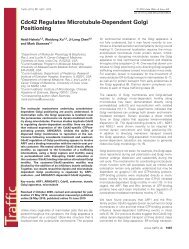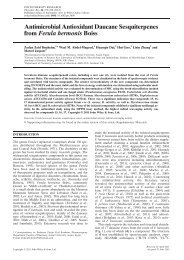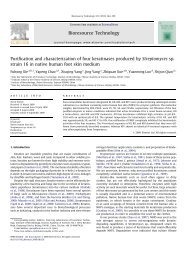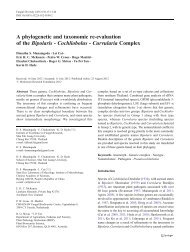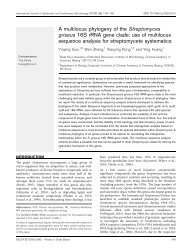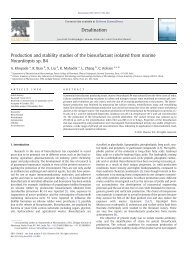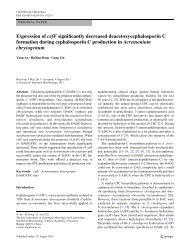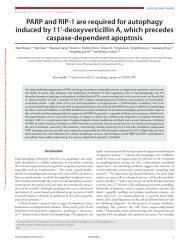Biochemical and structural characterization of Cren7, a novel ...
Biochemical and structural characterization of Cren7, a novel ...
Biochemical and structural characterization of Cren7, a novel ...
You also want an ePaper? Increase the reach of your titles
YUMPU automatically turns print PDFs into web optimized ePapers that Google loves.
1136 Nucleic Acids Research, 2008, Vol. 36, No. 4<br />
The two intercalating amino acid residues are substituted<br />
for by two conserved hydrophobic residues (L28 <strong>and</strong> V36)<br />
in the <strong>Cren7</strong> family (Figure 1B), which appear to be<br />
properly positioned in the protein structure (Figure 5D) to<br />
serve a role similar to that <strong>of</strong> V26 <strong>and</strong> M29 in Sac7d. So it<br />
is likely that <strong>Cren7</strong> also causes a sharp kink in bound<br />
dsDNA. Notably, however, <strong>Cren7</strong> differed from Sac7d in<br />
the ability to induce DNA distortions. In our topological<br />
assays, <strong>Cren7</strong> was significantly more efficient than Sul7d in<br />
constraining negative DNA supercoils, suggesting that the<br />
former is probably able to induce greater helix unwinding<br />
<strong>and</strong> larger kinks in DNA than the latter. This difference<br />
may be due to the presence <strong>of</strong> a longer flexible loop (L b3b4 )<br />
<strong>and</strong> a larger solvent-exposed hydrophobic patch at the<br />
DNA-binding surface in <strong>Cren7</strong> than in Sac7d.<br />
Additional major <strong>structural</strong> differences between <strong>Cren7</strong><br />
<strong>and</strong> Sul7d are present in the terminal regions <strong>of</strong> the two<br />
proteins. <strong>Cren7</strong> lacks the C-terminal a-helix present in<br />
Sac7d but possesses a flexible N-terminal loop absent<br />
in Sac7d. Both <strong>of</strong> these terminal regions are located opposite<br />
to the DNA-binding face <strong>of</strong> the protein <strong>and</strong>, therefore,<br />
are likely involved in protein–protein interactions. This<br />
notion is consistent with the finding that <strong>Cren7</strong> was<br />
capable <strong>of</strong> forming large complexes with duplex DNA<br />
fragments at higher protein concentrations.<br />
The presence <strong>of</strong> long <strong>and</strong> flexible loop L b3b4 <strong>and</strong><br />
N-terminal tail in <strong>Cren7</strong>, but not in Sac7d, also suggests<br />
that the interaction <strong>of</strong> the two proteins with DNA may<br />
be regulated differently. Residue K31 on loop Lb 3 b 4 in<br />
<strong>Cren7</strong> is partially methylated, <strong>and</strong> the N-terminal tail <strong>of</strong><br />
<strong>Cren7</strong> contains two serine <strong>and</strong> two lysine residues, which<br />
are <strong>of</strong>ten sites <strong>of</strong> phosphorylation <strong>and</strong> methylation or<br />
acetylation, respectively, in eukaryotic histones (36–38).<br />
Taken together, the ability <strong>of</strong> <strong>Cren7</strong> to constrain negative<br />
supercoils, form large complexes with dsDNA <strong>and</strong><br />
undergo potential regulatory modifications is consistent<br />
with a role for the protein in chromosomal organization.<br />
Archaea <strong>of</strong> the genus Sulfolobus synthesize copious<br />
amounts <strong>of</strong> both <strong>Cren7</strong> <strong>and</strong> Sul7d. It seems unlikely<br />
that either protein is an evolutionary fossil. So a question<br />
arises as to how the two proteins are evolutionarily <strong>and</strong><br />
functionally related. Presumably, both proteins serve<br />
important roles in chromosomal organization <strong>and</strong> their<br />
functions are not entirely redundant. The differences<br />
between the two proteins in function may have led to<br />
the loss in sequence similarity between them. Given its<br />
wide distribution, <strong>Cren7</strong> is probably the best c<strong>and</strong>idate for<br />
a major chromatin protein in Crenarchaea. The remarkable<br />
ability <strong>of</strong> the protein to distort DNA conformation is<br />
consistent with a role in DNA supercoiling <strong>and</strong> compaction.<br />
So our results reinforce the suggestion that Archaea<br />
employ two major strategies in chromatin compaction<br />
(26,33): one involves archaeal histones <strong>and</strong> the other uses<br />
the minor-groove binding proteins such as <strong>Cren7</strong>. While<br />
the histone-based strategy is primarily employed by the<br />
Euryarchaeota, the <strong>Cren7</strong>-based strategy may predominate<br />
in the Crenarchaeota. In Sulfolobus species, <strong>Cren7</strong><br />
<strong>and</strong> Sul7d (<strong>and</strong>, possibly, other unidentified chromatin<br />
proteins) may participate in chromosomal organization<br />
by forming functional complexes <strong>and</strong>/or interacting<br />
in a coordinated manner with DNA. The role <strong>of</strong> Sul7d<br />
is probably served by functional equivalents in other<br />
Crenarchaea.<br />
SUPPLEMENTARY DATA<br />
Supplementary Data are available at NAR Online.<br />
ACKNOWLEDGEMENTS<br />
We thank Danxia Yu for help in recombinant protein<br />
preparation. This work was supported by National Basic<br />
Research Program <strong>of</strong> China (2004CB719603 to L.H.);<br />
National Natural Science Foundation <strong>of</strong> China (30470025<br />
<strong>and</strong> 30621005 to L.H, 30570375 to J.W.); Chinese<br />
Academy <strong>of</strong> Sciences (KSCX2-YW-G-023 to L.H.,<br />
KSCX1-SW-17 to J.W.). Funding to pay the Open<br />
Access publication charges for this article was provided<br />
by National Natural Science Foundation <strong>of</strong> China<br />
(30470025).<br />
Conflict <strong>of</strong> interest statement. None declared.<br />
REFERENCES<br />
1. Luger,K., Mader,A.W., Richmond,R.K., Sargent,D.F. <strong>and</strong><br />
Richmond,T.J. (1997) Crystal structure <strong>of</strong> the nucleosome core<br />
particle at 2.8 angstrom resolution. Nature, 389, 251–260.<br />
2. Wu,L.J. (2004) Structure <strong>and</strong> segregation <strong>of</strong> the bacterial nucleoid.<br />
Curr. Opin. Genet. Dev., 14, 126–132.<br />
3. Dame,R.T. (2005) The role <strong>of</strong> nucleoid-associated proteins in the<br />
organization <strong>and</strong> compaction <strong>of</strong> bacterial chromatin.<br />
Mol. Microbiol., 56, 858–870.<br />
4. Reeve,J.N. (2003) Archaeal chromatin <strong>and</strong> transcription.<br />
Mol. Microbiol., 48, 587–598.<br />
5. S<strong>and</strong>man,K. <strong>and</strong> Reeve,J.N. (2005) Archaeal chromation proteins:<br />
different structures but common function? Curr. Opin. Microbiol., 8,<br />
656–661.<br />
6. Cubonova,L., S<strong>and</strong>man,K., Hallam,S.J., DeLong,E.F. <strong>and</strong><br />
Reeve,J.N. (2005) Histones in Cenarchaea. J. Bacteriol., 187,<br />
5482–5485.<br />
7. Grote,M., Dijk,J. <strong>and</strong> Reinhardt,R. (1986) Ribosomal <strong>and</strong> DNA<br />
binding proteins <strong>of</strong> the thermoacidophilic archaebacterium<br />
Sulfolobus acidocaldarius. Biochem. Biophys. Acta, 873, 405–413.<br />
8. Bell,S.D., Botting,C.H., Wardleworth,B.N., Jackson,S.P. <strong>and</strong><br />
White,M.F. (2002) The interaction <strong>of</strong> Alba, a conserved archaeal,<br />
chromatin protein, with Sir2 <strong>and</strong> its regulation by acetylation.<br />
Science, 296, 148–151.<br />
9. Luo,X., Schwarz-Linek,U., Botting,C.H., Hensel,R., Siebers,B. <strong>and</strong><br />
White,M.F. (2007) CC1, a <strong>novel</strong> crenarchaeal DNA binding<br />
protein. J. Bacteriol., 189, 403–409.<br />
10. Marsh,V.L., Peak-Chew,S.Y. <strong>and</strong> Bell,S.D. (2005) Sir2 <strong>and</strong> the<br />
acetyltransferase, Pat, regulate the archaeal chromatin protein,<br />
Alba. J. Biol. Chem., 280, 21122–21128.<br />
11. Guo,R., Xue,H. <strong>and</strong> Huang,L. (2003) Ssh10b, a conserved<br />
thermophilic archaeal protein, binds RNA in vivo. Mol. Microbiol.,<br />
50, 1605–1615.<br />
12. Baumann,H., Knapp,S., Lundback,T., Ladenstein,R. <strong>and</strong> Hard,T.<br />
(1994) Solution structure <strong>and</strong> DNA-binding properties <strong>of</strong> a<br />
thermostable protein from the archaeon Sulfolobus solfataricus.<br />
Nat. Struct. Biol., 1, 808–819.<br />
13. Chen,X.L., Guo,R., Huang,L. <strong>and</strong> Hong,R. (2002) Evolutionary<br />
conservation <strong>and</strong> DNA binding properties <strong>of</strong> the Ssh7 proteins<br />
from Sulfolobus shibatae. Sci. China Ser. C-Life Sci., 45, 583–592.<br />
14. Xue,H., Guo,R., Wen,Y.F., Liu,D.X. <strong>and</strong> Huang,L. (2000) An<br />
abundant DNA binding protein from the hyperthermophilic<br />
archaeon Sulfolobus shibatae affects DNA supercoiling in a<br />
temperature-dependent fashion. J. Bacteriol., 182, 3929–3933.<br />
15. Xiang,X.Y., Chen,L.M., Huang,X.X., Luo,Y.M., She,Q.X. <strong>and</strong><br />
Huang,L. (2005) Sulfolobus tengchongensis spindle-shaped virus





